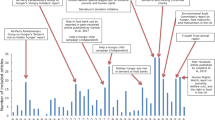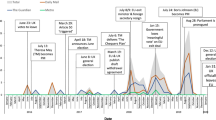Abstract
OBJECTIVES: Household food insecurity (HFI) affects approximately 13% of Canadian households and is especially prevalent among low-income households. Actions to address HFI have been occurring primarily at the local level, despite calls for greater income supports from senior governments to reduce poverty. News media may be reinforcing this trend, by emphasizing food-based solutions to HFI and the municipal level as the site where action needs to take place. The objective of this study was to examine the level and framing of print news media coverage of HFI action in Canada.
METHODS: Using a quantitative newspaper content analysis approach, we analyzed 547 articles gathered from 2 national and 16 local/regional English-language newspapers published between January 2007 and December 2012.
RESULTS: News coverage increased over time, and over half was produced from Ontario (33%) and British Columbia (22%) combined. Of the 374 articles that profiled a specific action, community gardens/urban agriculture was most commonly profiled (17%), followed by food banks/meal programs (13%); 70% of articles implicated governments to take action on HFI, and of these, 43% implicated municipal governments. Article tone was notably more negative when senior governments were profiled and more neutral and positive when municipal governments were profiled.
CONCLUSION: News media reporting of this issue in Canada may be placing pressure on municipalities to engage in food-based actions to address HFI. A more systematic approach to HFI action in Canada will require more balanced media reporting that acknowledges the limitations of food-based solutions to the income-based problem of HFI.
Résumé
OBJECTIFS: L’insécurité alimentaire des ménages (IAM) touche environ 13 % des ménages canadiens et prévaut particulièrement parmi les ménages à faible revenu. Les mesures de lutte contre l’IAM se prennent principalement à l’échelon local, malgré les appels à un meilleur soutien du revenu auprès des paliers de gouvernement supérieurs afin de réduire la pauvreté. Il est possible que les médias d’information renforcent cette tendance en mettant l’accent sur les solutions alimentaires à l’IAM et en faisant valoir que les mesures devraient se prendre à l’échelon municipal. Notre étude visait à examiner le palier de gouvernement et le cadrage de la couverture des mesures de lutte contre l’IAM présentés dans la presse écrite au Canada.
MÉTHODE: À l’aide d’une démarche d’analyse quantitative du contenu des journaux, nous avons analysé 547 articles recueillis dans deux journaux nationaux et 16 journaux locaux ou régionaux de langue anglaise parus entre janvier 2007 et décembre 2012.
RÉSULTATS: La couverture médiatique a augmenté avec le temps, et plus de la moitié des articles ont été rédigés soit en Ontario (33 %), soit en Colombie-Britannique (22 %). Sur les 374 articles portant sur une mesure particulière, les articles sur les jardins communautaires/l’agriculture urbaine ont été les plus courants (17 %), suivis de ceux sur les banques alimentaires/les programmes de dépannage alimentaire (13 %); 70 % des articles demandaient aux gouvernements d’agir pour contrer l’IAM, et de ce nombre, 43 % interpellaient les administrations municipales. Le ton des articles était remarquablement plus négatif quand il était question des paliers de gouvernement supérieurs et plus neutre ou positif quand il était question des administrations municipales.
CONCLUSION: Il est possible que les reportages des médias d’information sur cette question au Canada fassent pression sur les municipalités pour qu’elles prennent des mesures alimentaires afin de lutter contre l’IAM. Une démarche plus systématique pour aborder les mesures de lutte contre l’IAM au Canada nécessitera des reportages médiatiques plus équilibrés, qui reconnaissent les contraintes des solutions alimentaires au problème de l’IAM fondée sur le revenu.
Similar content being viewed by others
References
Statistics Canada. Household Food Insecurity, 2007–2008. Ottawa, ON: Statistics Canada, 2010.
Tarasuk V, Mitchell A, Dachner N. Household Food Insecurity in Canada, 2012. Research report. Toronto, ON, 2014. Available at: http://nutritionalsciences.lamp.utoronto.ca/wp-content/uploads/2014/05/Household_Food_Insecurity_ in_Canada-2012_ENG.pdf (Accessed May 16, 2016).
Kirkpatrick S, Tarasuk V. Food insecurity is associated with nutrient inadequacies among Canadian adults and adolescents. J Nutr 2008; 138:604–12. PMID: 18287374.
Vozoris N, Tarasuk V. Household food insufficiency is associated with poorer health. J Nutr 2003;133(1):120–26. PMID: 12514278.
Cook JT, Frank DA, Levenson SM, Neault NB, Heeren TC, Black MM, et al. Child food insecurity increases risks posed by household food insecurity to young children’s health. J Nutr 2006;136(4):1073–76. PMID: 16549481.
Kirkpatrick S, McIntyre L, Potestio ML. Child hunger and long-term adverse consequences for health. Arch Pediatr AdolescMed 2010;164(8):754–62. PMID: 20679167. doi: 10.1001/archpediatrics.2010.117.
Skalicky A, Meyers AF, Adams WG, Yang Z, Cook JT, Frank DA. Child food insecurity and iron deficiency anemia in low-income infants and toddlers in the United States. Matern ChildHealth J 2006;10(2):177–85. PMID: 16328705. doi: 10.1007/s10995-005-0036-0.
Jyoti DF, Frongillo EA, Jones SJ. Food insecurity affects school children’s academic performance, weight gain, and social skills. J Nutr 2005; 135(12):2831–39. PMID: 16317128.
McIntyre L, Williams JVA, Lavorato DH, Patten S. Depression and suicide ideation in late adolescence and early adulthood are an outcome of child hunger. J Affect Disord 2013;150(1):123–29. PMID: 23276702. doi: 10.1016/j. jad.2012.11.029.
Kneebone RD, White KG. Fiscal retrenchment and social assistance in Canada. Can Public Pol 2009;35(1):21–40. doi: 10.3138/cpp.35.1.21.
FCM. Building Prosperity from the Ground Up: Restoring Municipal Fiscal Imbalance. Ottawa, ON: Federation of Canadian Municipalities, 2006.
De Schutter O. Canada needs national food strategy, UN rep says. Canadian Meat Business: The Beef, Pork and Poultry Industry Magazine, 2012.
Power EM, Dietitians of Canada. Individual and household food insecurity in Canada: Position of Dietitians of Canada. Executive summary. Can J Diet Pract Res 2005; 66:43–46. PMID: 17068874. doi: 10.3148/66.1.2005.43.
Collins P, Power E, Little M. Municipal-level responses to household food insecurity in Canada: A call for critical, evaluative research. Can J PublicHealth 2014;105(2):e138–41. PMID: 24886850.
Firth C, Maye D, Pearson D. Developing “community” in community gardens. Local Environ 2011;16(6):555–68. doi: 10.1080/13549839.2011.586025.
Bellin R, Hunter A. Co-constructing the sustainable city: How indicators help us “grow” more than just food in community gardens. Local Environ 2011; 16(6):523–38. doi: 10.1080/13549839.2011.555393.
OPHA-FSWG. A Systemic Approach to Community Food Security: A Role for Public Health. Toronto, ON: Ontario Public Health Association Food Security Working Group, 2002.
OMAFRA. Urban Agriculture Business Information Bundle: Community Gardening. Toronto, ON: Ontario Ministry of Agriculture, Food and Rural Affairs. Available at: http://www.omafra.gov.on.ca/english/livestock/urbanagbib/communitygardening.htm (Accessed January 30, 2013).
Kirkpatrick S, Tarasuk V. Food insecurity and participation in community food programs among low-income Toronto families. Can J Public Health 2009; 100(2):135–39. PMID: 19839291.
Loopstra R, Tarasuk V. Perspectives on community gardens, community kitchens and the Good Food Box program in a community-based sample of low-income families. Can J Public Health 2013;104(1):55–59. PMID: 23618120.
Abelson J, Collins PA. Media hyping and the “Herceptin access story”: An analysis of Canadian and UK newspaper coverage. Healthc Policy 2009;4(3): e113–28. PMID: 19377347.
Collins P, Abelson J, Pyman H, Lavis J. Are we expecting too much from print media? An analysis of newspaper coverage of the 2002 Canadian healthcare reform debate. SocSciMed 2006;63(1):89–102. PMID: 16480808. doi: 10.1016/j.socscimed.2005.12.012.
Hayes M, Ross IE, Gasher M, Gutstein D, Dunn JR, Hackett RA. Telling stories: News media, health literacy and public policy in Canada. Soc Sci Med 2007; 64(9):1842–52. PMID: 17337317. doi: 10.1016/j.socscimed.2007.01.015.
Iyengar S. Do the Media Govern? Politicians, Voters, and Reporters in America. Thousand Oaks, CA: Sage Publications, 1997.
Seale C. Health and media: An overview. Sociol Health Ill 2003;25(6):513–31. PMID: 12919443. doi: 10.1111/1467-9566.t01-1-00356.
Riffe D, Lacy S, Fico FG. Analyzing Media Messages: Using Quantitative Content Analysis in Research, 2nd ed. Mahwah, NJ: Lawrence Erlbaum Associates Inc., 2008.
Soroka SN. Agenda-Setting Dynamics in Canada. Vancouver, BC: UBC Press, 2002.
Benelli E. The role of the media in steering public opinion on healthcare issues. Health Policy 2003;63(2):179–86. PMID: 12543530. doi: 10.1016/S0168-8510(02)00064-7.
Rock MJ, McIntyre L, Persaud SA, Thomas KL. A media advocacy intervention linking health disparities and food insecurity. Health Educ Res 2011;26(6):948–60. PMID: 21685402. doi: 10.1093/her/cyr043.
Jaquith M. An Assessment of Canadian Food Charters: Highlights and Recommendations for the KFL&A Healthy Eating Working Group. Kingston, ON: KFL&A Healthy Eating Working Group, KFL&A Public Health Unit, 2011.
MacRae R, Donahue K. Municipal Food Policy Entrepreneurs: A Preliminary Analysis ofHow Canadian Cities and Regional Districts are Involved in Food System Change. Toronto, ON: Toronto Food Policy Council, 2013.
Langdon M. Can Meals on Wheels get rolling again? Globe and Mail 2008 Sept 20.
Cornacchia C. Breadbasket reaches out to help more put food on the table. Montreal Gazette 2011 Sept 8.
Clarke B. Students dig in to secure future of communal garden. Globe and Mail 2010 Apr 1.
Shufelt T. Plan calls for new heights in agriculture. Ottawa Citizen 2008 Jul 1.
Grant T. Food-bank usage soars, study shows. Globe and Mail 2012 Oct 30.
Cuthand D. No appetite for aboriginals’ food security. Calgary Herald 2012 May 26.
Author information
Authors and Affiliations
Corresponding author
Additional information
Acknowledgement: This study was supported through funding from the Senate Advisory Research Committee at Queen’s University.
Conflict of Interest: None to declare.
Rights and permissions
About this article
Cite this article
Collins, P.A., Gaucher, M., Power, E.M. et al. Implicating municipalities in addressing household food insecurity in Canada: A pan-Canadian analysis of news print media coverage. Can J Public Health 107, e68–e74 (2016). https://doi.org/10.17269/cjph.107.5231
Received:
Accepted:
Published:
Issue Date:
DOI: https://doi.org/10.17269/cjph.107.5231




